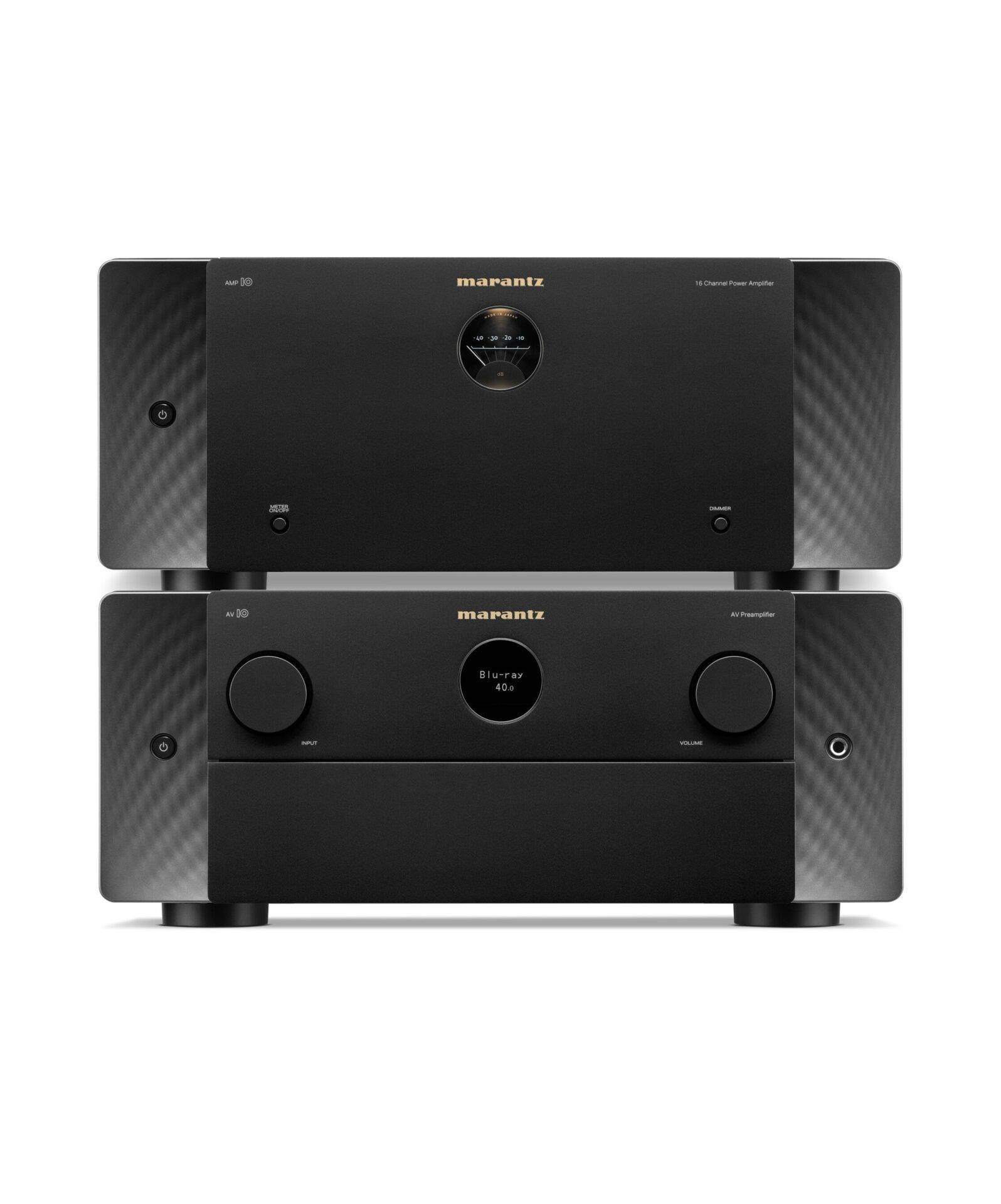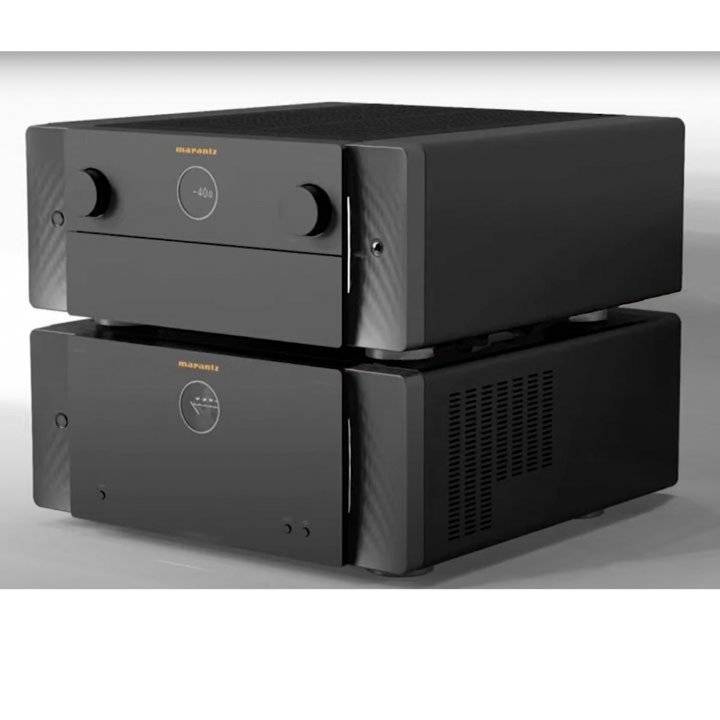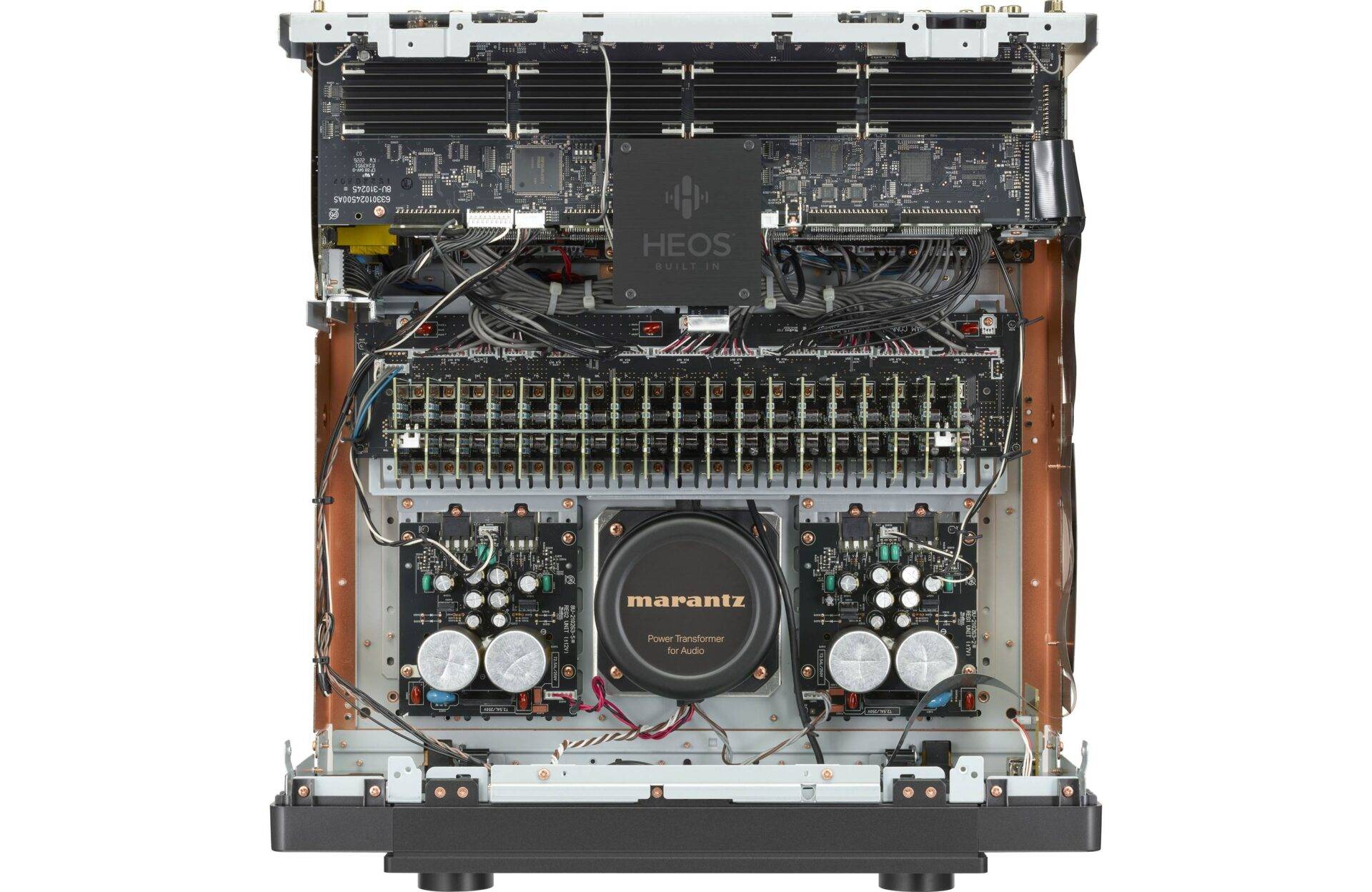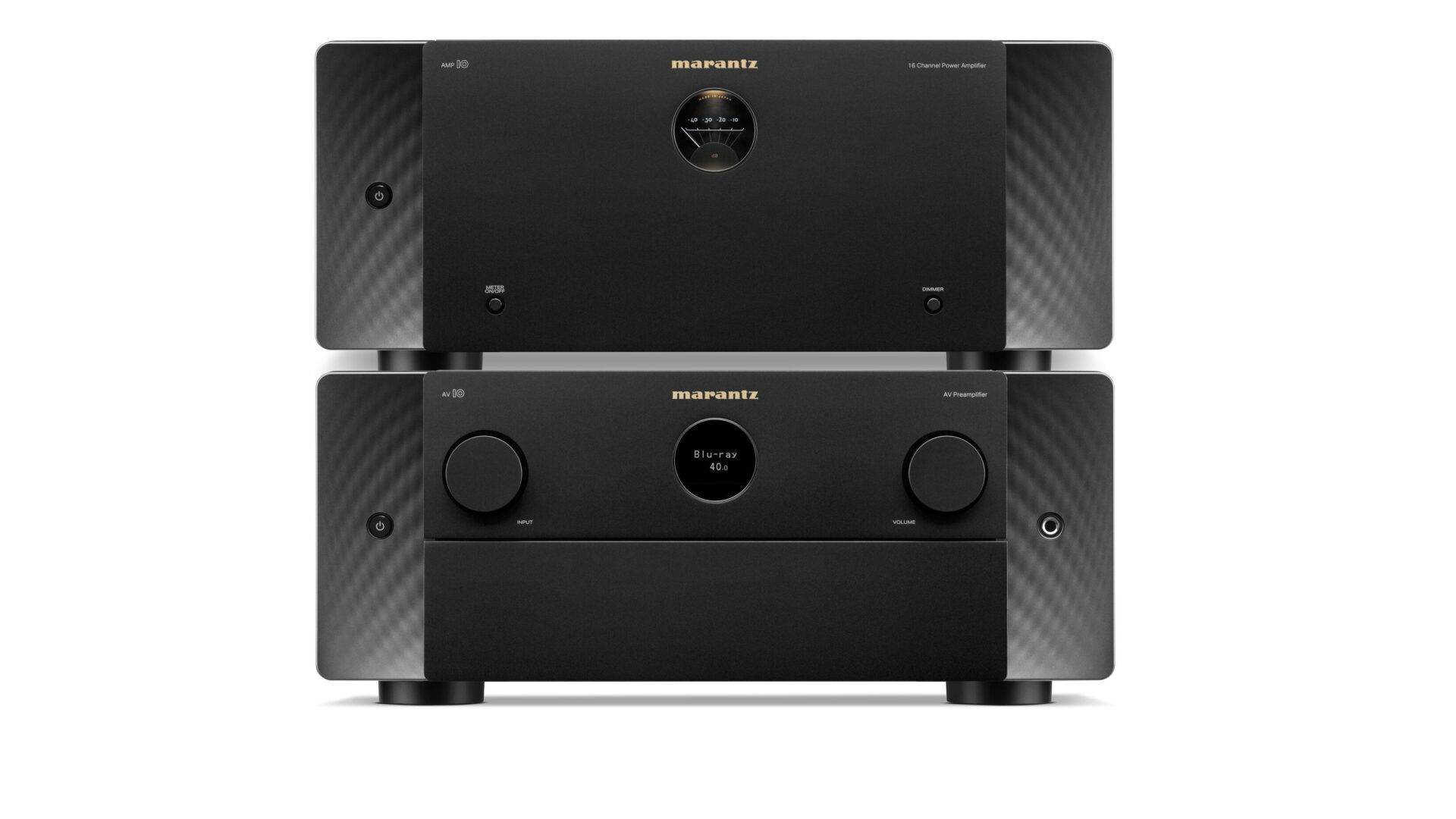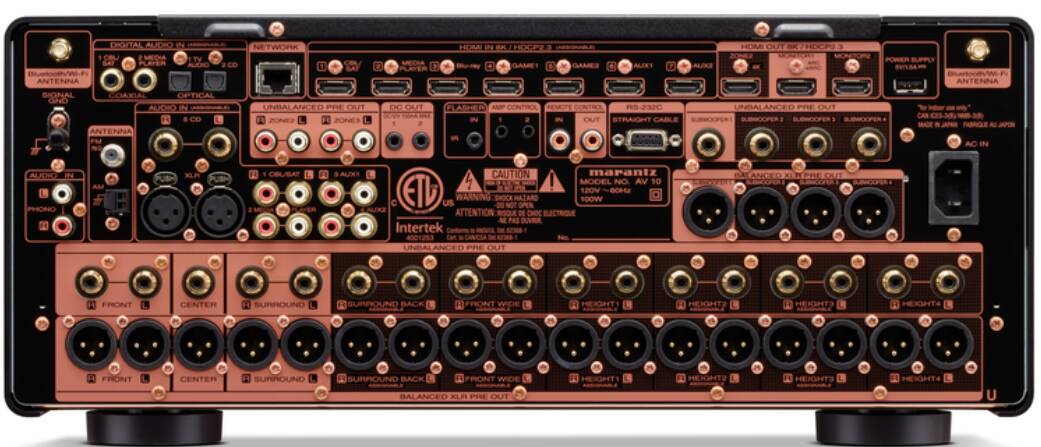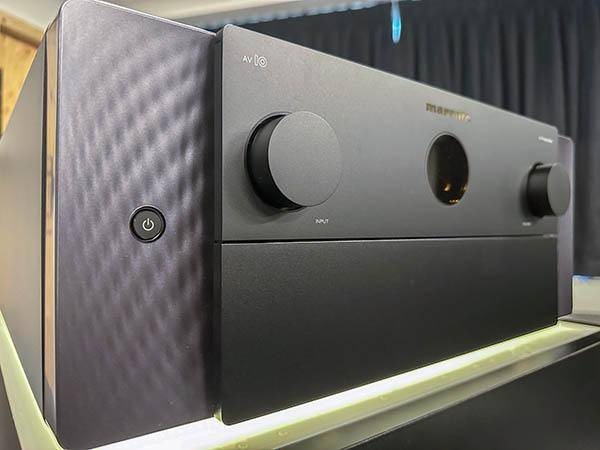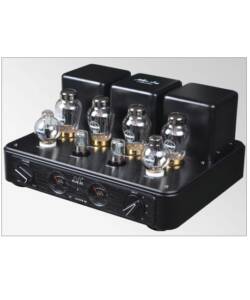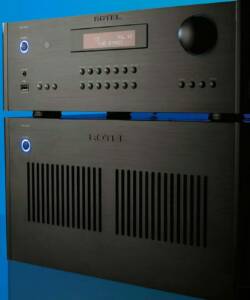Marantz AV10 & AMP10 – Ultimate 16ch AV System!!
Original price was: R410,000.00.R299,000.00Current price is: R299,000.00.
This system is $15000 new!!
Less than 6 months old
AV 10
Reference 15.4 Channel Balanced Processor with Dolby Atmos, DTS:X Pro Auro 3D, IMAX Enhanced and 8K Ultra HD, and HEOS® Built-in streaming. AV 10 is a reference-level AV processor.
- Crafted in Shirakawa, Japan
- 15.4 Channels
- 7 HDMI Inputs plus eARC
- 8K and Dolby Atmos
- 3D Audio
- HEOS Built-in
- 5 Year Warranty
AMP 10
Reference 16-channel 200-watt-per-channel amplifier. Pair with AV 10 to create an elite-level home theater. Marantz HDAM, Current Feedback Amplification, and balanced line level input.
- Crafted in Shirakawa, Japan
- 16 Channels
- 200 Watts per Channel
- Custom HDAM
- Custom Switching Amplifiers
- Selectable Output Modes
- 5 Year Warranty
Description
Marantz AV10 15.4-Channel AV Preamp/Processor Review

PRICE $7,000AT A GLANCE
Plus
Balanced outputs for all channels
Supports four subwoofers
Audyssey MultEQ XT32 with Directional Bass
Dirac Live Bass Control
Easy on-screen setup
Minus
Antiquated front panel interface
Dirac features cost extra
THE VERDICT
An engineering marvel from Marantz with just about everything you could ask for in an AV processor. Just add an amp and speakers for total immersion.
The AV processor is the less well-known sibling of the AV receiver. The main difference being that processors don’t have built-in amplification. This is a reasonable approach because as a rule amplifiers last a rather long time, and don’t come obsoleted by things like new immersive sound formats or updates to HDMI standards. Going the AV separate route also lets you tailor the amplification to the speaker system whereas AV receivers are forced to split the difference between whatever speakers are connected to it and hope for the best.
Typically, there’s a significant difference between an AV receiver rated at 100 watts per Channel, and an AV processor that is connected to a home theater amplifier rated at 100 watts per Channel. That difference is the “all channels driven” specification and with an AV receiver you might very well end up with only 30-40 watts per channel when all are driven simultaneously. If you use an AV processor with an amp rated at 100 Watts for all channels driven, you’ll get full power even with the toughest and most demanding audio content.
With the AV10, Marantz has created a new flagship. The review system consisted of the AV10 and AMP10 combo (the AMP10 is a 16-channel amplifier that is the perfect accompaniment to the AV10).
Features
For an overview of the features offered by the AV10, I suggest heading over to the Marantz website. Like cellphones, there’s so much IP inside an AV processor, it is more of a computing device than anything. The AV10 supports an array of multichannel surround formats, including DTS HD Master, DTS:X, DTS:X Pro, Dolby TrueHD, Dolby Atmos, Auro 3D, and IMAX Enhanced. It offers a maximum of 15.4 processing channels, offering a rich and immersive soundstage. The processor is equipped with Audyssey MultEQ XT32s with optional (paid) Dirac Live upgradability.
The AV10 includes HEOS Multi-room and Streaming, Bluetooth re-transmit for headphones, and compatibility with various voice assistants. For high-resolution audio enthusiasts, the AV10 supports various formats including FLAC, ALAC, WAV, and DSD Audio. It also works as a Roon player, a function I used for practically all of my music listening.
The HDMI specifications include 7 HDMI inputs, 2 main and 1 zone HDMI outputs, and supports 8K/60Hz and 4K/120Hz. Enhanced Audio Return Channel (eARC) and various HDR formats like Dolby Vision and HDR10+ are also supported. Gaming features like ALLM (Auto Low Latency Mode), Variable Refresh Rate, and Quick Frame Transport are included for minimal lag and smoother visuals.
The AV10 has already undergone testing for hardware performance by people like Amir at Audio Science Review and Gene at Audioholics, proving that it has top-notch fidelity. The upshot is that at this performance level what you are really hearing is transparency—the absence of distortion and noise. A peek under the hood reveals meticulous attention to detail.

Directional Bass is a newly supported Audyssey feature. I’ve heard it work effectively in demos where you’ll sense the bass energy coming from a general area that correlates to what’s on (or off) screen. I can see situations where, done right, it adds to a sense of total immersion. You can switch between directional and regular bass at will.
This is a three-zone device, so if you don’t use all the channels for a home theater system, you can effectively have it act as three separate audio processors, and with HDMI dual-zone support you can route two separate video sources to the zones of your choice.
Setup
I used the AV10 with three different speaker systems. The first was a 9.4.4 system featuring Arendal Sound 1961 speakers and subs, reviewed in the August/September 2023 issue. The intent being to (almost) max out the processor’s channel count. The second system was a 5.4 Bowers & Wilkins speaker system. This had a pair of 703 S3 towers, a pair of 705 S3 bookshelf speakers, the HTM71 S2 center, and four Bowers & Wilkins DB3D subs—the speakers and subs are also reviewed in this issue. Here the focus is on quality. And the third? A 5.2 system consisting of Pioneer XPRS powered PA speakers and subs, each connected directly to the AV10 via balanced XLR cables.
I do have one ergonomic complaint, which is that using the front panel and its monochrome display makes it tough to quickly adjust a setting. But with the on-screen display it’s a lot easier to just use the TV. I relied on room correction to set levels and distances.
Performance
Every second I spent listening to the AV10 was a pleasure, and a quick estimate reveals I’ve listened to the AV10 for over two million seconds. It can be difficult to pinpoint what makes a complex surround-sound system sound great but ultimately, it’s the sum of various parts working together effectively.
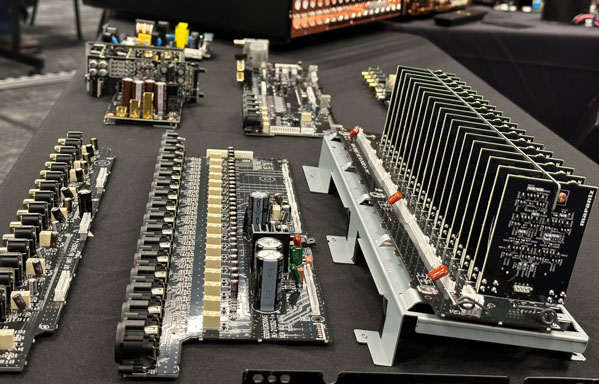
It is no coincidence I was able to tune three totally different speaker systems to a level of performance where they sound transparent and totally at ease with any material. Each time I watched a movie, what came through is how well the speakers are tuned to create proper immer-sion—regardless of how many or what type of speakers I used.
With the Arendal Sound 1961 9.4.4 system, nine of the speakers were tower models, and the entire system is rated at 4 ohms. If you task an AVR with driving all of that, you’ll likely leave up to 6 dB of output on the table compared to robust external amplification. Even without driving all channels simultaneously you’ll start taxing the power supply before the amps themselves reach their output limit. The AMP10 is still power supply-limited, but much less than an AVR. It’s a class D amplifier, so very little of the power it draws from its switch-mode power supply/toroidal transformer combo is wasted and found it a perfect match for the 1961s.
Since the 1961 subs don’t have XLR inputs, I used long RCA cables with no audible noise/hum. They also lack DSP tuning, so I relied entirely on the AV10 to handle bass EQ. The result?
A system that amazed with its cohesiveness. I certainly credit the AV10 with making it all work. Without needing to deep dive into its many settings, the standard Audyssey routines and then manually choosing 80 Hz for a crossover to the subs worked out great. With the subs running in sealed mode, I saw measured extension right down to 10 Hz.
The Bowers & Wilkins 5.4-system, despite the much lower speaker and channel count, is the best-sounding rig I’ve reviewed in the past year and one of the top systems ever. Here, with only five speakers to power, the option exists to bridge the channels on the AMP10, or to biamp all five speakers. But it hardly matters how you wire it up unless you like pushing gear to its limits. I like gear I never need to max out; with only five speakers to power, the AMP10 had an easy time of it.
The combo of Bowers & Wilkins and Marantz is under the same corporate umbrella, Sound United. And based on aesthetics and price points, you can hardly find a better match for the Marantz system than the 700 S3 series speakers. I found the sense of immersion, from simple 5.1 audio, was still incredibly enveloping. How? Because the entire system delivered true high-fidelity audio; the entire soundfield was effectively holographic. The only thing missing was explicit over-head effects, which can always be added with more speakers, and I can only imagine what could be achieved if you maxed out the AV10’s channel count with 700 S3 speakers. Still, movie after movie sounded seamless, never any issues with dialog clarity.
The four DB3D subs in the Bowers & Wilkins system were situated in the same spots that I put the Arendal Sound 1961 subwoofers—basically two up front and two behind the seating area. The correction curve Audyssey chose is nearly identical for the Bowers & Wilkins and for the Arendal Sound subwoofers. It indicates the room correction system truly is just correcting for the room (and succeeding).
The Bowers & Wilkins plus Marantz AV10/AMP10 system showed the value of spending on quality over quality. I did not expect the overall effect to be more aurally appealing than the Arendal Sound system, but many times I simply liked it better. As subjective a judgment as that is, it is how I feel.
And then there’s the Pioneer PA system. No need for the AMP10, and they lean heavily on room correction and EQ to play nice in a home theater. This is not new territory for me, years ago on AVS Forum I started a thread about using Behringer B215XLs as home theater speakers. It was a popular choice for those who accept letting room correction fix the response curve. The result, you get amazing output and dynamics for comparatively little dough versus “home” speakers.
These Pioneer speakers are a lot nicer and more capable than those Behringers. And they accept a balanced XLR signal, so they work optimally with the AV10. And guess what? Holy crap! I’m listening to it as I type this. They are crisp, clear, smooth and dynamic. They image well and retain a proper soundstage when sitting off center. But there is one catch, the PA subs Pioneer shipped with them are big and loud but don’t play all that deep. So, I left the four Bowers & Wilkins DB3D subs hooked up and used them with the Pioneers. While an effing expletive does the most justice to how awesome that combo worked out, what I will spell out is that it throbs and shakes and gets guttural while also dicing and slicing like an Iron Chef. It sounds like a nightclub!
With powered PA speakers, the entire system is free to play to its maximum potential. Pioneer claims 131 dB peak output. That’s irrelevant to me aside from describing how much headroom there is: tons.
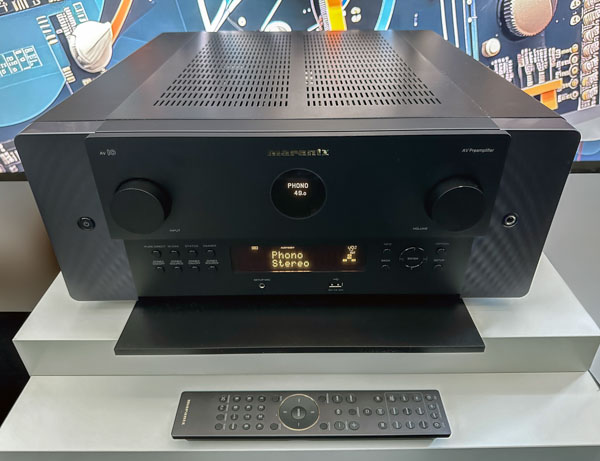
So, the cat is out of the bag. I will be reviewing the full Pioneer system in an upcoming issue. But I do want to touch on what happens if you use the Pioneer subs instead of the Bowers & Wilkins subs. This is a 5.2 system with three XPRS 122 speakers (L/C/R) and two XPRS 102 speakers as surrounds. The subs are the XPRS 1152S, a 15-inch ported sub designed for live music/PA duty so, its spec only goes down to 45 Hz (-6 dB) but promises up to 129 dB SPL output (to roughly match the speakers).

What happens if you let the AV10 tune the Pioneer sub system? I let Audyssey have a go at it. You get nicely tuned sound, with proper EQ and very powerful bass. But not bloated at all, the sub’s sound is totally transformed! They play flat, right down to 45 Hz as the specs state. At which point the sub literally cuts everything off! Oh well. It’s a brick wall, you get nothing below 45 Hz. Such is the engineering “cost” of building a high-output sub that does not self-destruct. So what benefit is there? Well, let’s just say there’s a ton of output in the range that live music uses. Get it? Live music, just like what these speakers were designed to play.
45 Hz extension is no good for home theater, but dang I can get into a ton of trouble playing hip-hop and reggae dub classics through this rig. It slams, whether it’s Black Uhuru’s Dub Experience or Mobb Deep’s The Infamous. For something more modern in production, yet classic in sound, a thorough and deep listening to Metallic Spheres in Colour by The Orb and David Gilmour was as trippy and absorbing and inter-esting as with any other speaker system I have tried. It just emphasizes different qualities versus the other speakers, it’s more direct and able to cleanly achieve output levels the other speaker systems could not touch. Also, the Pioneer subs make nice stands for the speakers!
So, the AV10 can tame even an unruly active PA speaker system, making it into a credible system for music, or blending them with home theater subs. And it can make top-tier speakers strut their stuff, so much so it can coax a 5.1-channel Bowers & Wilkins system into outperforming the already great Arendal Sound 9.4.4 1961 system. This ability to sort through the issues and deliver the best each system has to offer is a sign of a great processor, one that has a good chance of properly handling whatever an owner might throw at it.
If the purpose of a performance section is to find limitations and describe them, I’d be stuck complaining that the remote control. Nice as it is that the faceplate is a piece of metal, it still uses IR instead of Bluetooth, and has tiny buttons that are hard to read.
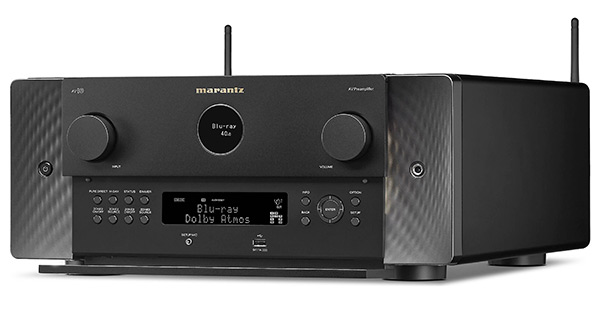
Do you see where I am going with this? The AV10 is beyond what I need, but also is also everything I desire in an AV processor. Sure, I know there’s Trinnov and StormAudio out there, promising even more channels and even more sophisticated room correction. But that’s the thing, with the AV10 I’m already done, with overkill. I don’t see jumping from a four-figure MSRP into the world of five-figure price tag processors gaining me anything, I’d rather put the money into speakers and subs because the AV10 is already an endgame AV processor.
Conclusion
One word says it all: superlative. The AV10 is a dream machine. That’s the main thing you need to know. And unless you are doing a billionaire-level home theater, it can probably handle whatever it is you need it to do, just like how for me, it handled three dramatically different speaker systems and made each of them into a compelling, cohesive listening experience. It proved its capability and adaptability in real life.
If you are willing and able to invest in separate amplification, the AV10 is at once incredibly powerful yet surprisingly accessible. It is a consumer product, but one with professional capability that can take your home theater or living room system to new heights of audio fidelity and AV content playback.
Another three amazing reviews:
https://www.audioholics.com/amplifier-reviews/marantz-amp-10-test-report
https://www.audiosciencereview.com/forum/index.php?threads/marantz-av10-av-processor-review.50041/
https://www.audioholics.com/av-preamp-processor-reviews/marantz-av-10-15.4ch-processor
Marantz AV10 / AMP10 AV Processor And Amplifier Review
 Tony O’Brien auditions a superb high-end processor and multichannel power amplifier combination…
Tony O’Brien auditions a superb high-end processor and multichannel power amplifier combination…
Marantz
AV10 Surround Processor | AMP10 Power Amplifier
USD $7,000 each
Marantz is a name that needs little in the way of introduction. Currently celebrating its seventieth birthday year, this illustrious audio company has just released what it states is its finest-sounding AV products to date. Enter the new 15.4-channel AV10 processor and AMP10 16-channel power amplifier, said to be made with the design brief of being the company’s finest-sounding cinema product ever – in Marantz’s words, “the cinephile’s dream”.
THE PROCESSOR
To achieve this lofty sound quality standard, noise reduction was key. To this end, a three-layer aluminium chassis is used, which rests upon polycarbonate feet. This results in the unit being free of internal vibrations, while a copper grounding plate ensures not only low impedance but the cleanest signal path, the company says.
Internally, analogue and digital sections are kept separate, with the digital side of the board sporting a Griffin Lite XP DSP Digital Signal Processor. Marantz says that this was chosen for its processing power, enabling the AV10 to handle up to fifteen channels and four independent subwoofer outputs. It also decodes all formats, including Dolby Atmos DTS: X Pro, Auro-3D and IMAX Enhanced and MPEG-H Audio. There’s also enough power on tap for the AV10 to have both Audyssey MultEQ XT32 and Dirac Live room correction, the latter of which is available through a paid upgrade.
Digital signals need to be converted to analogue; to this end, ten 32-bit, hi-fi-grade stereo ESS 9018 DACs are specified. Channel allocation has been carefully considered, with more active channels sharing a DAC with less active channels, such as surrounds or heights, to reduce channel crosstalk, while a four-layer copper PCB helps further. To alleviate timing artefacts such as jitter, the AV10 utilises a precise crystal low-phase noise master clock. Marantz’s proprietary HDAM3 technology is used in the analogue stage, said to deliver clarity and precision.
The preamplifier circuit board has also been redesigned, incorporating a four-layer or quad design with the analogue, digital and power circuitry occupying different board layers. This not only reduces noise but improves overall clarity, it is claimed. A toroidal power transformer with low impedance OFC winding is specified, feeding a linear power supply housed in an aluminium case and resting upon an aluminium base plate.
The company specifies a signal-to-noise ratio of 106dB (THD+N), which is said to be a big improvement on that of the company’s own AV-8805, with its quoted S/N ratio of 93dB. It also yields improvements in dynamic range, the AV10 supposedly having a 4dB increase. Final voicing was done by Marantz’s Sound Master Yoshinori Ogata, who set out to get an expansive soundstage with an excellent sense of width, depth, and height – plus a high level of focus and detail, with a fast and tight bass.
THE POWER AMPLIFIER
The AMP10 also employs a rigid aluminium case with a copper baseplate for grounding and stability, with polycarbonate feet to reduce vibration. Internal shielding has been utilised for everything from the power amplifier module –which reduces cross-talk to other modules – to the centre chassis shield that separates the audio circuits from the power supply.
Marantz’s HDAM-SA2 or Hyper Dynamic Amplifier Modules are used in the gain stages, with Class D power modules said to be designed and built in-house from hand-picked components. Equipped with eight stereo amplifier modules (sixteen channels total), the signal path never leaves the amplifier board. A switching power supply is fitted for digital circuits, and OFC-wound toroidal transformers for the analogue ones; large capacitors are featured with discrete power supplies for each amplifier block.
The result is an amplifier with an extremely low noise floor, providing a 10dB improvement over the existing MM8807, it is claimed. Power-wise, it’s rated at a solid 200 watts per channel (8 ohms, 0.7% THD+N, both channels driven) or 400 watts into 4 ohms. Unlike many amplifiers – including Marantz’s own MM8807 – the AMP10 can maintain the same power rating in multichannel mode and can be bi-amped or operated in Bridged Tier Load for more power.
UP CLOSE
A departure from previous Marantz designs, the AV10 and AMP 10 sport a two-tone finish, a matt black aluminium face plate offset against a textured grey. The porthole design remains, though, with Marantz likening it to a luxury watch face. Save for power and input selector dials, all controls are tucked behind a metal door. It’s here that you’ll also find a larger, more informative LCD, with information regarding the source, incoming format and the number of speakers being used. As stylish as the porthole is, it’s not practical if you use the front-panel display for anything more than the volume level.
Practicality meets good looks around the back of the AV10, with Marantz’s brass-on-black colour scheme. Here you’ll find both balanced and unbalanced preamp outs (17.4 for both) and seven 8K HDCP 2.3 inputs, and three 8K HDMI, including Zone 2. Arguably, the star of the show is the AV10’s four independent subwoofer outputs, with input for tactile transducers. There’s a wealth of connections on offer, including two coaxial and optical digital inputs, five analogue inputs, dual multi-room analogue inputs, a USB audio input, an Ethernet connection, two 12V DC Outputs, an IR input, twin AMP Control inputs, remote control input and output and an RS232C connection. The AV10 supports wireless and Bluetooth control through mountable rabbit ears.
Equally as stylish, the AMP10 features a VU meter that displays the incoming signal of channel one. The rear offers the choice of sixteen assignable balanced and unbalanced inputs. Next to each channel is an input selector with options for normal, bi-amp or BTL. It uses expensive hi-fi grade speaker terminals, capable of accommodating the largest of wires. Marantz has also included a custom wrench to ensure a snug fit for bare wire connections. Build quality is nothing short of perfection, and the all-metal remote control is a joy to use.
GETTING GOING
This combo proved surprisingly easy to set up. I broke convention by connecting the AV10 to the AMP10 with an unbalanced connection. While sorely tempted and I had the channels to spare, I kept the AMP10 in normal mode rather than BTL. I’ve long held the opinion that both Marantz and Denon components are the crème de la crème when it comes to usability. And I’m pleased to report that apart from a facelift to the GUI, this hasn’t changed. Hook the pair up to each other and your TV and projector and follow the prompts, simple as that.
The onscreen display guides the user through every step, including striping speaker wires and connecting speakers. AV grandmasters will undoubtedly frown upon such hand-holding, but it’s worth completing the process if nothing more than ensuring everything’s properly connected. It also includes a crash course on how to run Audyssey, although it’s the bare-bones approach to room correction. For the more familiar and those willing to learn, there’s an abundance of other, better options available.
Audyssey’s MultEQ app, for instance, which is available through the Apple App- and Google Play stores, provides significantly more control, including the ability to create custom room curves. If, like me, you find app-based solutions clumsy, Audyssey X PC software is also available, adding yet more control, including custom filters. Or should you want to go down an entirely different path, you can download Dirac Live at a cost. Unfortunately, Dirac Live Bass Control is unavailable, but I’m quietly hoping it will be offered as an upgrade.
For this review, the AV10 and AMP10 were connected to VAF Signature i91 front and centre speakers; four VAF i90s were used as rear surround and ceiling-mounted Atmos speakers, with two Definitive Technology DN12 subwoofers for a 5.2.2 Atmos layout. The fourth subwoofer output was connected to a Crowson D-501 Tactile Motion Amplifier, in turn, connected to dual Shadow-8 Dual Motion Actuators placed at the main listening position. Video sources comprised an OPPO UDP-203 and Apple TV, connected directly to a Lumagen Radiance Pro 5348, with a Sony VPL-XW5000ES projecting images onto a Severtson 100” Cinegray 16.9 screen.
MOVIE NIGHTS
The AV10 and AMP10 blend both hi-fi and home cinema for a listening experience that is distinctly high-end. Wonderfully transparent and detailed, they can reveal the finest detail and breathe new life into recordings. They pair to produce a wide, open soundstage with a fine sense of height, depth, and width. Refined as they are, though, they know when it’s time to put on the gloves. The AMP10 produces a seemingly endless amount of power, with powerful, lightning-fast dynamics. This is underpinned with fast and punchy bass that brings a cinema-like level of performance into the home.
Settled in for an evening anime session with my daughter, I decided to see what the AV10 and AMP10 would make of the decidedly un-cinephile 2.0 soundtrack of Demon Slayer. With the now-familiar opening score, the pair possessed wonderful transparency and musicality. So much so that I was drawn out of the show at times, marvelling at the sound pouring out of the speakers.
There’s an undeniable musicality to this pair that’s both distinctly Marantz, yet unlike any other Marantz that I’ve listened to. Musically pleasing as Marantz components can be, I sometimes find them a little fuzzy, yet I had no such misgivings with the AV10 and AMP10. There’s a wonderful transparency to the sound that is both revealing, yet musical. The strings of the shamisen in the opening score of Demon Slayer reached right into my room.
While Beast starring Idris Elba on Blu-ray would have undoubtedly benefited from a Dolby Atmos track, the DTS-HD 7.1 soundtrack nonetheless proved formidable. From the moment the Universal logo appeared, I knew I was in for something special. There was a clarity to the sound that breathed new life into the all-too-familiar introduction. As the film began, the Marantz combo created an immense sense of space. The sounds of the jungle came to life, with the soundstage exhibiting a marvellous sense of height – and the width was no less impressive from left to right.
Moving to the excellent DTS-X soundtrack on the 4K Blu-ray of Gladiator, the AV10 and AMP10 expertly combined the worlds of hi-fi and home cinema. As Maximus glided through wheatfields, the orchestral score was delivered with a startling sense of musicality and clarity. The various wind and string instruments all possessed a clear sense of precision. Having heard this on a number of systems, it can come across as a molasses-like mess, but not here.
As the Romans prepared to attack the Germanic Barbarians, the sound of the fire pots being lit elicited plenty of low-end detail from the subwoofers. As the action began, the taunting of the barbarians and explosions was a full-frontal assault on the senses. In fact, it bordered on uncomfortable at my usual listening levels, with the AV10 and AMP10 producing impressive dynamics that create a very cinema-like performance.
With the radio chatter between American tank crews in the opening scenes of Fury, the pair created cast a massive soundstage with the Dolby Atmos soundtrack. Meanwhile, every little movement or whisper inside the tank was produced in remarkable detail. The dialogue never missed a beat, and the thick American accents were delivered with the same level of clarity. When the shelling resumed, and the Sherman growled into life, the bass was tight and articulate, and the rumble of exploding shells was clearly felt. With the American tank crews facing off against the entrenched Germans, the Marantz combo put in an impressive performance. As machine guns burst into life, the AMP10 followed suit with immense power and speed. With the couch-mounted tactile inducers engaged, things got even more exciting – with the AV10 passing the signal to the transducers just as it should, untouched by Audyssey.
Switching to the familiar DTS-HD Master of Wolverine, the AV10 and AMP10 turned in one of the better performances that I’ve heard. As Logan went head-to-head with Yakuza on top of a bullet train, it possessed all of the sonic fury that you would expect. Using directional bass – which disengages the tactile transducers – did seem to lend more weight to effects on either side of the listening position. With only two subwoofers at the front of the room, the benefits of directional bass were marginal.
THE VERDICT
 I came away thoroughly impressed by Marantz’s new AV10 and AMP10 processor and power amp combination. This dynamic duo proved to be a resounding success that lives up to its promises. It produces a massive, open soundstage with a very tangible sense of depth and height. It walks a fine line between musicality and elegance yet still manages to create a home cinema dynamo. Overall then, highly recommended!
I came away thoroughly impressed by Marantz’s new AV10 and AMP10 processor and power amp combination. This dynamic duo proved to be a resounding success that lives up to its promises. It produces a massive, open soundstage with a very tangible sense of depth and height. It walks a fine line between musicality and elegance yet still manages to create a home cinema dynamo. Overall then, highly recommended!
